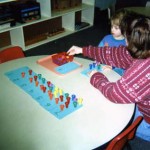 Alayna asks: I’m curious about your take on the many therapies often suggested for right brained kids who are struggling with academics. Vision, auditory, occupational… Is it always necessary or are we forcing a developmental process that would unfold on its own anyway?
Alayna asks: I’m curious about your take on the many therapies often suggested for right brained kids who are struggling with academics. Vision, auditory, occupational… Is it always necessary or are we forcing a developmental process that would unfold on its own anyway?
I reply: This is one of the most important questions that need answered. It’s at the foundation of everything I talk about regarding right-brained learning. And here’s the two-fold answer: 1) You can’t force development without potential negative consequences; you can only provide an environment that nurtures a person’s natural developmental process in order for that child to reach his potential, and 2) We are each born with a bent that includes strengths and weaknesses, and when you work with that bent, it’s a beautiful thing; we’re meant to have both strengths and weaknesses.
Let’s start with my first answer and using learning to walk as an example. I’ve known children to walk anywhere from 9 months old to 18 months old. That’s a 9 month spread difference at a time when you’ve only lived 2 times that amount at the higher end of the ratio. Can you speed the process up for the 18 month old walker? Maybe by a month or two, but if developmentally, that child was meant to walk at about 16-18 months old, that’s when it’ll happen. Otherwise, wouldn’t we have many more under 12 month old walkers than we do?
 What we can do is provide an environment conducive to learning to walk. And we can note the “pre-skills” that helps us know that it will happen. Strong legs can be noted as a young baby pushes up while sitting in your lap.
What we can do is provide an environment conducive to learning to walk. And we can note the “pre-skills” that helps us know that it will happen. Strong legs can be noted as a young baby pushes up while sitting in your lap.
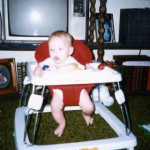
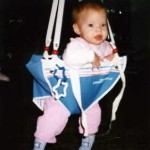 We can provide “tools” that give opportunity to practice pre-skills like leg strengthening or usage, such as a baby walker or a baby jumper.
We can provide “tools” that give opportunity to practice pre-skills like leg strengthening or usage, such as a baby walker or a baby jumper.

 We take note how the natural environment is used by our young child, such as when they use the family couch to pull themselves up, or when something inter-esting, like the toilet, gets their attention.
We take note how the natural environment is used by our young child, such as when they use the family couch to pull themselves up, or when something inter-esting, like the toilet, gets their attention.
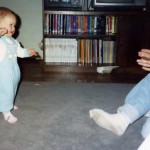
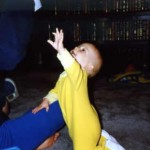 And last, we have our own encouragement that we add. We might hold something of high interest up for them to reach for, or we clap enthusiastically when our young children make their first attempts at walking.
And last, we have our own encouragement that we add. We might hold something of high interest up for them to reach for, or we clap enthusiastically when our young children make their first attempts at walking.
We haven’t determined that babies need to walk by twelve months old (the average age babies walk) and start to give therapies to those who don’t. Yet, we’ve determined children should learn to read, for instance, by 6-7 years old, and so I see we begin to teach reading now at 4-5 years old thinking that it will help them learn to read by 6-7, and if 6-7 comes and a child isn’t reading, people are already jumping on the therapy bandwagon to make it so. And who determined that 6-7 years old is when all children should be able to read?
There’s a natural developmental process to learning for both left- and right-brained learners as I outlined in a previous post. Because parents, teachers, and experts don’t understand this difference, they are determining a right-brained child is “broken” strictly because he isn’t reading, writing, spelling, or retaining math facts at a particular time in a particular way based on the left-brained developmental process. Sometime, somehow, we’ve decided as a society that the time and way schools teach is the one right way to learn. That’s false. There’s a right side of normal, too.
Let’s explore the idea that so many believe “early intervention” for “dyslexia” with “specialized programs” need to occur to give any “hope” for “successful remediation” to result. I’ve noticed one of two results. The first is a “dyslexia intervention program” is started at 5 to 6 years old, and some time in the 8 to 10 year age range, the “dyslexic child” suddenly begins to read proficiently. Here’s the deal. A program shouldn’t take 2 to 4 years to work. In actuality, what happened is that the right-brained child hit his natural developmental time frame for learning to read, between 8 and 10 years old, and despite the intervention, takes off in reading.
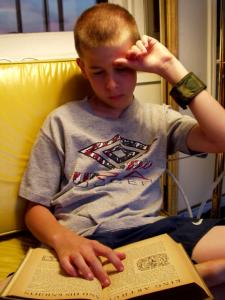 The second result is the same thing occurs: a “dyslexic intervention program” is started at 5 to 6 years old and it retrains the brain enough that though the child begins to read, he continues to be a slow and laborious reader throughout his life. In actuality, what happened is the right-brained child was trained out of his natural developmental time and way to read, and so he’ll never be a proficient reader. In their new book, The Dyslexic Advantage, Brock Eide, M.D., M.A., and Fernette Eide, M.D., conclude: “If it is true that the ‘dyslexic difference’ in cognition is due entirely to the greater tendency to use right-hemispheric circuits, then we would expect that training sufficient to produce a right-to-left processing shift would cause individuals with dyslexia to become ‘just like everyone else’ in their cognitive style. But this is not, in fact, what we see.
The second result is the same thing occurs: a “dyslexic intervention program” is started at 5 to 6 years old and it retrains the brain enough that though the child begins to read, he continues to be a slow and laborious reader throughout his life. In actuality, what happened is the right-brained child was trained out of his natural developmental time and way to read, and so he’ll never be a proficient reader. In their new book, The Dyslexic Advantage, Brock Eide, M.D., M.A., and Fernette Eide, M.D., conclude: “If it is true that the ‘dyslexic difference’ in cognition is due entirely to the greater tendency to use right-hemispheric circuits, then we would expect that training sufficient to produce a right-to-left processing shift would cause individuals with dyslexia to become ‘just like everyone else’ in their cognitive style. But this is not, in fact, what we see.
…Individuals with dyslexia who are trained sufficiently to produce the kind of right-to-left shift in their reading circuit that we described above usually don’t become indistinguishable from fully ‘normal’ readers but instead become their own unique variety of highly skilled ‘dyslexic readers.’ What we mean is that these dyslexic readers still generally read more slowly than comparably bright nondyslexics, and they also still display the same highly interconnected, gist- and context-dependent imagery-based, big-picture reading comprehension style shown by most other individuals with dyslexia.”
The good news is that there’s a valid and painless way and time for right-brained children to come to reading that unfolds naturally; it doesn’t have to be forced. But we (as parents, teachers, and experts) have to develop trust in the right-brained developmental process enough to wait. This is true for math facts, writing, spelling, and any other subject development that happens at a later time frame than those found in school for left-brained learners. Is your child’s love of learning and feeling of competency worth the wait? I think so. Others have concurred:
The second part to my answer to the original question is that we’re born with specific genetic and temperament traits that factor into readiness for various skills.
Brain dominance is genetically encoded. You’re born to be right-brained or left-brained, based on your parents. You’ll be introverted or extroverted (part of your temperament) based on genetics. I would even think that your preferred input modality (auditory, visual, or kinesthetic) is probably genetic. Each of these combine to create strengths and weaknesses. Brain dominance creates the foundation for how and when a person will learn, and temperament and input modality preferences will influence that foundation.
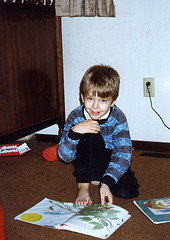 So, let’s take my oldest artist son. Genetics were strong right-brained learner, introvert, auditory and visual learner, highly verbal, and gifted intelligence. He learned to read at 9. Pre-skills were that he loved to look at books since starting at 1 … for hours. He loved listening to read alouds. He was always asking me questions about what was in a book. Why would I think he wouldn’t read? But so many people would get him tested, see he had a gifted IQ, think his ability to read should come early because of his intelligence factor and verbal ability, and yet, there’s no evidence saying that’s true. He progressed to reading exactly as a typical right-brained learner does because of his three-dimensional and pictorial development happening between 5 and 7 years old.
So, let’s take my oldest artist son. Genetics were strong right-brained learner, introvert, auditory and visual learner, highly verbal, and gifted intelligence. He learned to read at 9. Pre-skills were that he loved to look at books since starting at 1 … for hours. He loved listening to read alouds. He was always asking me questions about what was in a book. Why would I think he wouldn’t read? But so many people would get him tested, see he had a gifted IQ, think his ability to read should come early because of his intelligence factor and verbal ability, and yet, there’s no evidence saying that’s true. He progressed to reading exactly as a typical right-brained learner does because of his three-dimensional and pictorial development happening between 5 and 7 years old.
Let’s take my third builder son. His genetics were right-brained learner, introvert, spatial and kinesthetic learner, memory/attention differences, and sweet but needy personality. Other genetic and/or environmental factors include auditory processing weakness (with chronic ear infections), and disordered language (diagnosed with high functioning autism). He learned to read between 10 and 11. Pre-skills were that he had a strong  curiosity for figuring things out. He was a puzzle-it-out kid. He wasn’t drawn to books whatsoever, but he would use visual material to learn and figure things out, like LEGO diagrams, how things work books, and visual experiments. He didn’t sit in for read alouds because he couldn’t process it auditorially nor could he because of his language differences. Yet, this kiddo had skills spatially speaking. I wanted to give him space to grow into his language abilities before worrying about the reading part. I did offer opportunity with periodic reading lessons (that lasted about 2 weeks each time), Earobics (an auditory and memory development computer program he chose to do from time to time), and some language development games at home with someone I trained to sit one-on-one with him.
curiosity for figuring things out. He was a puzzle-it-out kid. He wasn’t drawn to books whatsoever, but he would use visual material to learn and figure things out, like LEGO diagrams, how things work books, and visual experiments. He didn’t sit in for read alouds because he couldn’t process it auditorially nor could he because of his language differences. Yet, this kiddo had skills spatially speaking. I wanted to give him space to grow into his language abilities before worrying about the reading part. I did offer opportunity with periodic reading lessons (that lasted about 2 weeks each time), Earobics (an auditory and memory development computer program he chose to do from time to time), and some language development games at home with someone I trained to sit one-on-one with him.
From 5-10 my builder son developed his amazing spatial strengths through building things, math development, and music. From 10-13 my builder son developed his reading skills (was reading computer programming books by 13), his memory skills developed through maturity of his strong right-brained  visualization skills by 14, his auditory skills developed from 14-18 years old when he could really collaborate to make a difference. Not only has he successfully attended college as he pursues his strengths toward a computer science degree, but he chose to serve a full-time mission which envelopes all his “weaknesses.”
visualization skills by 14, his auditory skills developed from 14-18 years old when he could really collaborate to make a difference. Not only has he successfully attended college as he pursues his strengths toward a computer science degree, but he chose to serve a full-time mission which envelopes all his “weaknesses.”
 Too many people would have seen his obvious weaknesses as a young boy, got him diagnosed with a thousand things, started heavy interventions with him, particularly reading, writing, spelling … and, well, everything except math. He would’ve been miserable, thought himself stupid, and probably not even developed his strengths that were there. Instead, I saw his genetic make-up and went with it. He developed his strengths when he was supposed to, he came to the other subjects when he was supposed to, and he’s a competent, intelligent, and confident young man today because of it.
Too many people would have seen his obvious weaknesses as a young boy, got him diagnosed with a thousand things, started heavy interventions with him, particularly reading, writing, spelling … and, well, everything except math. He would’ve been miserable, thought himself stupid, and probably not even developed his strengths that were there. Instead, I saw his genetic make-up and went with it. He developed his strengths when he was supposed to, he came to the other subjects when he was supposed to, and he’s a competent, intelligent, and confident young man today because of it.
I give these two examples so everyone understands that I’ve had a typical right-brained learner in my artist son, and I had a right-brained learner that had other difficulties in my builder son. Many people with children diagnosed with learning disabilities will be like my artist son. Many of these children are simply typical right-brained learners whose parents and teachers don’t understand the right-brained learning time frame. If this natural development for right-brained children is honored, I believe many learning disabilities would disappear. Some right-brained children will have a few extra differences, like my builder son. Nonetheless, the natural development for right-brained children is still highly relevant, maybe more so. Memory, attention, sensory, and input modality weaknesses (like auditory) require maturation and skill development at the appropriate developmental time frame versus special therapies. (That will take another post.) Even language for this builder son didn’t require abnormal intervention. Most therapies and interventions were created and exist to force all children to fit into the learning stage time frames of left-brained learners … even though they’re right-brained learners.
Bottom line to the original question, here are some quotes from the experts:
Brock Eide, M.D., M.A., and Fernette Eide, M.D., in The Mislabeled Child, “…too often we try to teach children using only a narrow range of options. This narrow approach actually aggravates — and in some cases even causes — many of the learning difficulties children encounter.”
Thomas Armstrong, Ph.D., in the preface to In Their Own Way, “Six years ago I quit my job as a learning disabilities specialist. I had to. I no longer believed in learning disabilities.”
Brock Eide, M.D., M.A., and Fernette Eide, M.D., in The Dyslexic Advantage, “If it is true that the ‘dyslexic difference’ in cognition is due entirely to the greater tendency to use right-hemispheric circuits, then we would expect that training sufficient to produce a right-to-left processing shift would cause individuals with dyslexia to become ‘just like everyone else’ in their cognitive style. But this is not, in fact, what we see.
…Individuals with dyslexia who are trained sufficiently to produce the kind of right-to-left shift in their reading circuit that we described above usually don’t become indistinguishable from fully ‘normal’ readers but instead become their own unique variety of highly skilled ‘dyslexic readers.’ What we mean is that these dyslexic readers still generally read more slowly than comparably bright nondyslexics, and they also still display the same highly interconnected, gist- and context-dependent imagery-based, big-picture reading comprehension style shown by most other individuals with dyslexia.”
Mel Levine, M.D., in A Mind at a Time, “Planet Earth is inhabited by all kinds of people who have all kinds of minds. The brain of each human is unique. Some minds are wired to create symphonies and sonnets, while others are fitted out to build bridges, highways, and computers; design airplanes and road systems; drive trucks and taxicabs; or seek cures for breast cancer and hypertension. The growth of our society and the progress of the world are dependent on our commitment to fostering in our children, and among ourselves, the coexistence and mutual respect of these many different kinds of minds. Parents have a special responsibility and joy as they get to know well and to cultivate their children’s individual minds. Tragic results are seen when we misconstrue and possibly even misuse a child’s kind of mind! And that happens all the time.
On countless evenings I have driven home from work feeling emotionally depleted, dejected after listening to the sad tales of children who have come to equate education with humiliation. Many of them have been forced to accept labels for themselves, labels that mark them as somehow permanently deviant or dysfunctional, labels like ADD (attention deficit disorder) or LD (learning disability). Others have been placed willy-nilly on several drugs to somehow settle or sedate or soothe their kinds of minds. Adding to the torturous trails they navigate many struggling students have been seriously wounded by the current testing mania in our society. Their intellectual identity has been shrunken down to a list of examination scores that will determine their destinies while shedding little light on their true strengths, weaknesses, and educational needs.”
As Dr. Levine beautifully states, right-brained children grow up to bless the world with their strengths, gifts, and talents IF they survive the horror that school can often put them through. We think the right-brained process is broken because we don’t understand it. We’ve been conditioned to believe that the left-brained scope and sequence is normal and anything else is broken.
Professionals have created “interventions” for making right-brained children abide by the left-brained time frame. But, as the Eides have clearly stated, not only does it not work, it creates a weird new “abnormal” and yet, all the strengths of being right-brained doesn’t go away (thank goodness!). And so the search continues for what’s wrong. But no one is asking, “What if nothing is wrong?” The Eides are finally coming out to say, “Hey, maybe we’ve been wrong all this time. What if it isn’t a disorder (dyslexia)? What if it’s another way to learn with strengths that go along with it?”
I’m not saying that certain therapies don’t have their place (see my post here). But what’s really happening is that professionals and parents are viewing right-brained children as abnormal, and we are creating therapies to fix something that isn’t broken. There’s a natural process for learning for right-brained children that looks different from those who are left-brained. The right-brained path to learning needs to be recognized, valued, and honored.
Question: What fears prevent us from trusting the natural learning process for right-brained children?
If you benefited from this content, please consider supporting me by buying access to all of my premium content for a one-time fee of $15 found here. This will even include a 50% off e-mail link toward a copy of my popular The Right Side of Normal e-book (regularly $11.95)!






6 responses to “My Reader’s Ask: Are We Using Therapies to Force a Developmental Process That Will Unfold Naturally?”